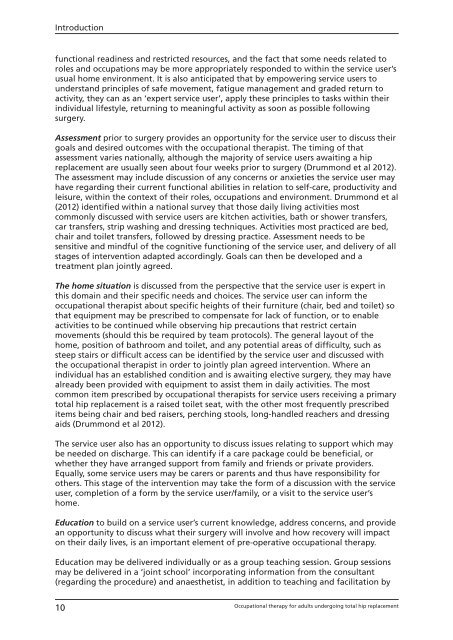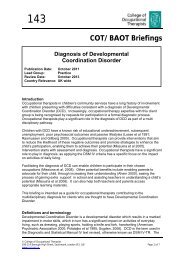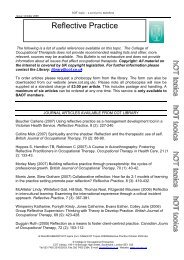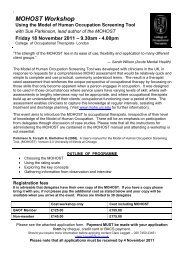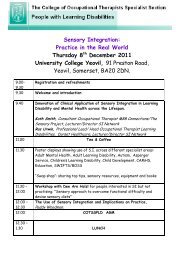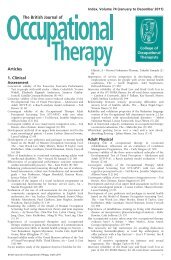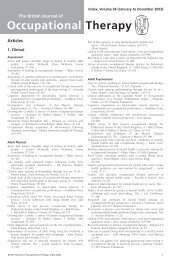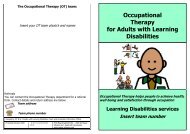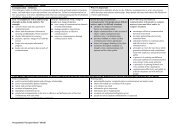Total hip replacement - College of Occupational Therapists
Total hip replacement - College of Occupational Therapists
Total hip replacement - College of Occupational Therapists
You also want an ePaper? Increase the reach of your titles
YUMPU automatically turns print PDFs into web optimized ePapers that Google loves.
Introduction<br />
functional readiness and restricted resources, and the fact that some needs related to<br />
roles and occupations may be more appropriately responded to within the service user’s<br />
usual home environment. It is also anticipated that by empowering service users to<br />
understand principles <strong>of</strong> safe movement, fatigue management and graded return to<br />
activity, they can as an ‘expert service user’, apply these principles to tasks within their<br />
individual lifestyle, returning to meaningful activity as soon as possible following<br />
surgery.<br />
Assessment prior to surgery provides an opportunity for the service user to discuss their<br />
goals and desired outcomes with the occupational therapist. The timing <strong>of</strong> that<br />
assessment varies nationally, although the majority <strong>of</strong> service users awaiting a <strong>hip</strong><br />
<strong>replacement</strong> are usually seen about four weeks prior to surgery (Drummond et al 2012).<br />
The assessment may include discussion <strong>of</strong> any concerns or anxieties the service user may<br />
have regarding their current functional abilities in relation to self- care, productivity and<br />
leisure, within the context <strong>of</strong> their roles, occupations and environment. Drummond et al<br />
(2012) identified within a national survey that those daily living activities most<br />
commonly discussed with service users are kitchen activities, bath or shower transfers,<br />
car transfers, strip washing and dressing techniques. Activities most practiced are bed,<br />
chair and toilet transfers, followed by dressing practice. Assessment needs to be<br />
sensitive and mindful <strong>of</strong> the cognitive functioning <strong>of</strong> the service user, and delivery <strong>of</strong> all<br />
stages <strong>of</strong> intervention adapted accordingly. Goals can then be developed and a<br />
treatment plan jointly agreed.<br />
The home situation is discussed from the perspective that the service user is expert in<br />
this domain and their specific needs and choices. The service user can inform the<br />
occupational therapist about specific heights <strong>of</strong> their furniture (chair, bed and toilet) so<br />
that equipment may be prescribed to compensate for lack <strong>of</strong> function, or to enable<br />
activities to be continued while observing <strong>hip</strong> precautions that restrict certain<br />
movements (should this be required by team protocols). The general layout <strong>of</strong> the<br />
home, position <strong>of</strong> bathroom and toilet, and any potential areas <strong>of</strong> difficulty, such as<br />
steep stairs or difficult access can be identified by the service user and discussed with<br />
the occupational therapist in order to jointly plan agreed intervention. Where an<br />
individual has an established condition and is awaiting elective surgery, they may have<br />
already been provided with equipment to assist them in daily activities. The most<br />
common item prescribed by occupational therapists for service users receiving a primary<br />
total <strong>hip</strong> <strong>replacement</strong> is a raised toilet seat, with the other most frequently prescribed<br />
items being chair and bed raisers, perching stools, long- handled reachers and dressing<br />
aids (Drummond et al 2012).<br />
The service user also has an opportunity to discuss issues relating to support which may<br />
be needed on discharge. This can identify if a care package could be beneficial, or<br />
whether they have arranged support from family and friends or private providers.<br />
Equally, some service users may be carers or parents and thus have responsibility for<br />
others. This stage <strong>of</strong> the intervention may take the form <strong>of</strong> a discussion with the service<br />
user, completion <strong>of</strong> a form by the service user/family, or a visit to the service user’s<br />
home.<br />
Education to build on a service user’s current knowledge, address concerns, and provide<br />
an opportunity to discuss what their surgery will involve and how recovery will impact<br />
on their daily lives, is an important element <strong>of</strong> pre- operative occupational therapy.<br />
Education may be delivered individually or as a group teaching session. Group sessions<br />
may be delivered in a ‘joint school’ incorporating information from the consultant<br />
(regarding the procedure) and anaesthetist, in addition to teaching and facilitation by<br />
10<br />
<strong>Occupational</strong> therapy for adults undergoing total <strong>hip</strong> <strong>replacement</strong>


